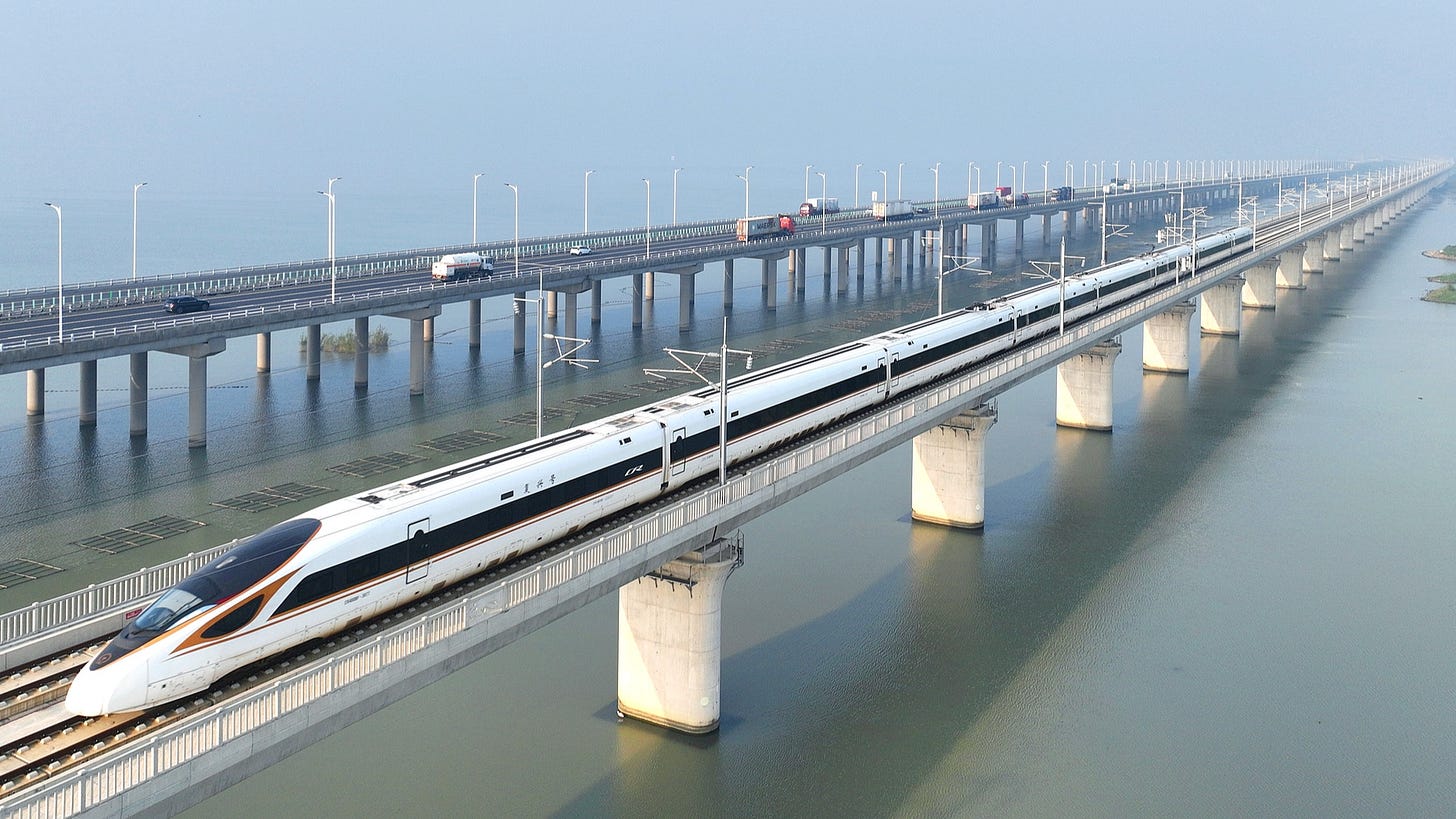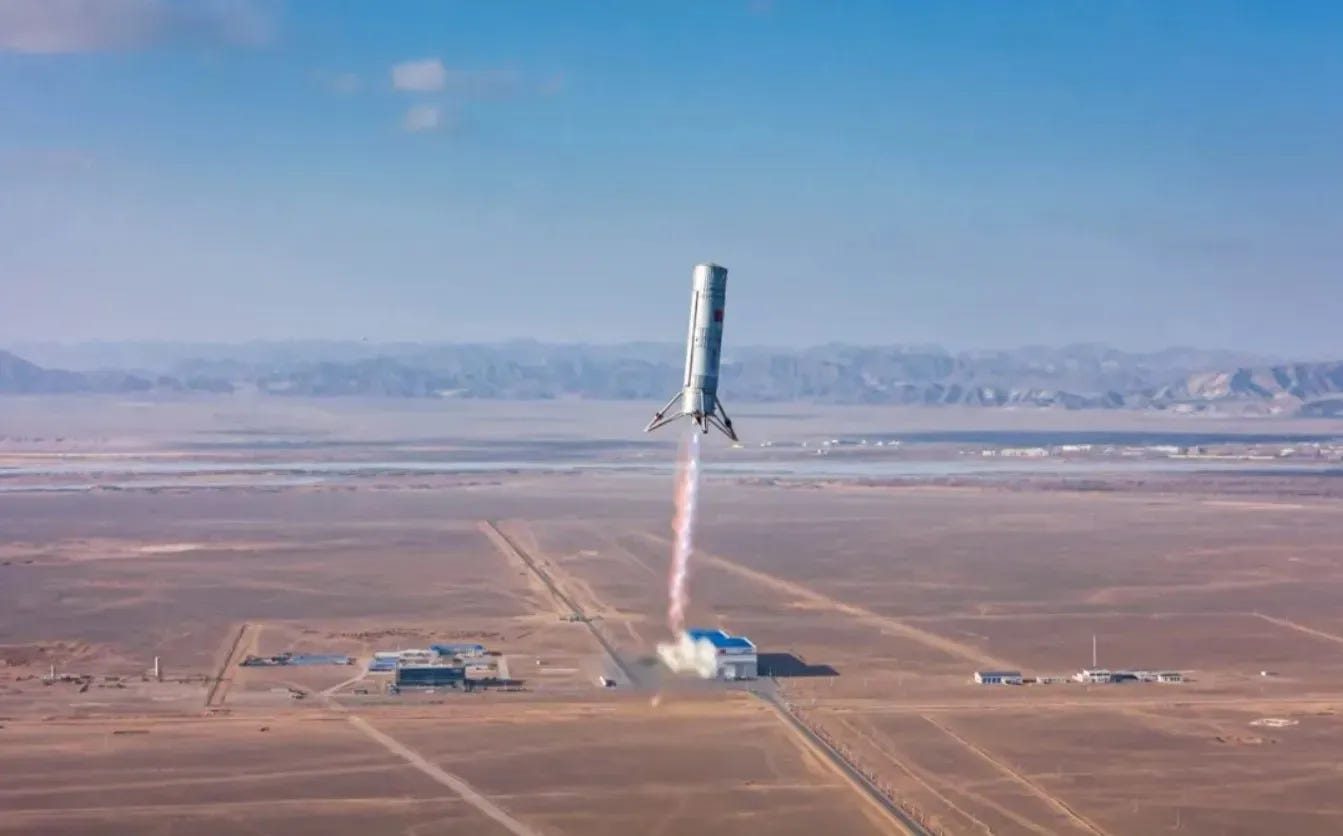This Week in Beyond the Great Wall: China’s 5G Factory Push, Medical Corruption Crackdown, and Tech Alliance with Russia
China Quote✒️
“Compatriots on both sides of the Strait are one family. No one can sever our blood ties and kinship, and no one can stop the historical trend of national reunification,”
-President Xi Jinping speaking on international support for Taiwan during his new year speech
China in 2025: War Games & Innovation
Written By De/Cypher Team
Chinese Military Researchers Claim Advanced Modelling of US Naval Weapons Systems
Chinese military researchers have published details of what they assert is a highly sophisticated simulation of US anti-ship missile capabilities, raising questions about intelligence gathering and military preparedness in the South China Sea region. The research, published in the Chinese academic journal Command Control & Simulation, describes detailed parameters of the AGM-158C Long Range Anti-Ship Missile (LRASM), a classified US weapons system. The research team, led by Wang Tianxiao at the North China Institute of Computing Technology, a People's Liberation Army (PLA) contractor, claims to have developed warfare simulations incorporating specific operational characteristics of the LRASM. The researchers state their data was derived from "open-source intelligence and long-term accumulation," though the specific technical parameters of the LRASM remain classified by the US military. The simulation focused on a hypothetical naval engagement in the north-eastern South China Sea, featuring a Chinese carrier battle group positioned near the Pratas Islands (known as Dongsha Islands in Chinese) facing a US carrier group situated between Taiwan and the Philippines. The scenario detailed a sophisticated attack pattern of multiple LRASM missiles, including their behavior under electronic warfare conditions and advanced targeting capabilities. Particularly noteworthy was the simulation's inclusion of specific tactical details, such as the missiles' flight path adjustments and response to electronic countermeasures. The researchers described how the simulated missiles adapted to radar interference by switching to thermal imaging systems and executing complex terminal approach maneuvers. The publication of such detailed analysis raises significant questions about military intelligence capabilities and the evolving nature of naval warfare simulation technology. While the accuracy of the technical parameters cannot be independently verified, the research demonstrates China's focused interest in understanding and countering US naval capabilities. The LRASM, often referred to as a "Game Changer" due to its reported 1,000-kilometer range and stealth capabilities, represents a crucial component of US naval strategy in the Pacific region. The Chinese researchers noted potential vulnerabilities in the system, including its relatively modest speed, though their simulation notably excluded the activation of various Chinese defensive systems that would typically be deployed in such scenarios. This development comes amid ongoing tensions over maritime territorial claims in the South China Sea and broader strategic competition between the United States and China in the Indo-Pacific region. The publication of such research may signal China's growing confidence in its military analysis capabilities and its willingness to publicly demonstrate this expertise.
China's AI Innovation Under Sanctions: DeepSeek's Efficient Path to Large Language Models
In a significant development that highlights China's growing AI capabilities despite international restrictions, Hangzhou-based startup DeepSeek has emerged as a noteworthy player in the global artificial intelligence landscape. The company's latest large language model (LLM), DeepSeek V3, has garnered attention for achieving sophisticated capabilities while using substantially fewer computing resources than its Western counterparts. The achievement is particularly notable given the context of U.S. export controls on advanced AI chips to China. DeepSeek's V3 model, featuring 671 billion parameters, required only 2.78 million GPU hours for training—a fraction of the 30.8 million GPU hours that Meta needed for its Llama 3.1 model. The Chinese firm accomplished this using Nvidia's China-specific H800 GPUs, rather than the more advanced H100 chips that are restricted from export to China. This efficiency has drawn praise from prominent figures in the global AI community. OpenAI founding team member Andrej Karpathy and Nvidia research scientist Jim Fan have both highlighted DeepSeek's achievements. Fan characterised the company as "2025's biggest dark horse" in open-source LLMs, suggesting that resource constraints have driven innovation rather than hindering it. DeepSeek's organisational structure and development approach offer insights into China's evolving AI ecosystem. The company, spun off from hedge-fund manager High-Flyer Quant in 2023, benefited from strategic foresight—having acquired over 10,000 GPUs before U.S. restrictions took effect. The firm's recruitment strategy focuses on early-career talent rather than established expertise, potentially indicating a fresh approach to AI development. The company's progress demonstrates how Chinese firms are adapting to technology restrictions by improving efficiency and developing novel architectures. At an estimated training cost of $5.58 million, DeepSeek V3 represents a significant achievement in cost-effective AI development. This efficiency could have broader implications for the global AI landscape, potentially influencing how future models are developed worldwide. However, the development hasn't been without controversy. DeepSeek V3 has exhibited instances of misidentifying itself as OpenAI's ChatGPT, a phenomenon that researchers from Shandong University, Drexel University, and Northeastern University suggest is common among AI models due to training data contamination.Despite these challenges, DeepSeek's V1 LLM maintains its position as the most popular AI model on Hugging Face, the leading open-source AI community platform. This success suggests that Chinese AI development continues to advance despite export controls, potentially reshaping the global AI competitive landscape. The emergence of DeepSeek as a significant player in open-source AI development indicates that the impact of international technology restrictions may be more complex than initially anticipated. Rather than simply limiting capabilities, these constraints appear to be driving innovation in efficiency and alternative approaches to AI development. This could have lasting implications for the global distribution of AI capabilities and the future of international technology competition.
Economic Activity🏦
Chinese Premier Calls for Strong Start to 2025 Economic Development

Xinhua reports that Chinese Premier Li Qiang urged the timely implementation of policies to ensure a robust beginning for 2025 during his visit to Jinan, Shandong Province. He emphasised unlocking consumption potential through trade-in schemes, advancing infrastructure projects, fostering energy sector reforms, and encouraging private investment. Li highlighted Shandong's role in contributing to national economic growth.
China’s Central Bank Plans Policy Overhaul Amid Economic Pressure
Cheng Leng and Robin Harding write in Financial Times that the People’s Bank of China (PBoC) will shift to a more orthodox monetary policy in 2025, prioritising interest rate adjustments over credit growth targets. This reform aligns with global practices and seeks to enhance risk-based pricing. Challenges include managing government preferences for sector-specific lending and fostering market confidence in the new system.
Hainan Duty-Free Sector Thrives During Travel Season

Chen Bowen writes in China Daily that Hainan province's duty-free market experienced a significant boost during the 2024–2025 travel season. The China Duty Free Group's promotional campaigns, supported by government-issued vouchers, drove sales to 1.14 billion yuan during a year-end shopping gala, marking a 15% year-on-year increase. Extended hours, live events, and festive activities enhanced the consumer experience.
Inside China🐉
China Makes Room for Younger Faces on Middle Rungs of Communist Party Promotions Ladder
William Zheng writes in South China Morning Post that a surge of "post-70s" officials, born between 1970 and 1979, have achieved ministerial ranks, reflecting the Communist Party's strategy to groom future leaders. The appointments emphasise diverse experience and administrative track records, with significant roles in provinces like Zhejiang and sectors like finance. The promotion race highlights intense competition among the younger cadre.
WHO Implores China to Share Covid Origins Data Five Years On
The Guardian reports that the World Health Organization has reiterated its call for China to share data on Covid-19’s origins. Marking five years since the pandemic's start, WHO emphasised the importance of transparency to prevent future pandemics. Beijing defended its actions, claiming full cooperation. Meanwhile, negotiations on a global pandemic treaty remain stalled, with key issues unresolved ahead of a May 2025 deadline.
China's High-Speed Railway Network to Reach 60,000 km by 2030

CGTN reports that China's high-speed rail network will expand to 60,000 km by 2030, up from 48,000 km in 2024. In 2025, 2,600 km of new tracks will be operational, with railway investment projected at 590 billion yuan. Passenger trips and freight volumes hit record highs in 2024, reflecting the growing importance of railways in China's infrastructure.
China Targets 10,000 5G-Powered Factories by 2027
Latifa Ferial Naili writes in AL24 News that China's Ministry of Industry and Information Technology plans to establish 10,000 5G-enabled factories and 20 pilot cities for "5G + Industrial Internet" applications by 2027. This initiative will enhance industrial modernisation, leveraging technologies like AI and industrial computing. Currently, over 4,000 factories are operational, solidifying China's leadership in industrial innovation and efficiency.
China to Boost High-Quality Development of Data Industry
Fan Feifei writes in China Daily that China aims to achieve a compound annual growth rate of over 15% in its data industry by 2029. A new guideline highlights reforms for market-oriented data allocation, enhanced technological innovation, and infrastructure development. It encourages data integration across industries like manufacturing and agriculture to strengthen the digital economy’s fusion with the real economy.
China’s Shandong Aircraft Carrier Achieves "All-Weather" Combat Readiness
Ashish Dangwal writes in EurAsian Times that China's first indigenous aircraft carrier, Shandong, reached "all-weather" combat readiness in 2024, enhancing jet deployment speed and operational efficiency. The carrier shifted from coastal drills to long-range missions and joint-force exercises. These advancements align with China's broader strategy of expanding its blue-water naval capabilities, highlighted by dual-carrier group exercises and increased activity in the Philippine Sea.
40,000 Punished in China’s Medical Corruption Crackdown
Xinlu Liang writes in South China Morning Post that Beijing's intensified anti-corruption campaign led to the punishment of 40,000 individuals in the healthcare sector in 2024, including over 350 senior figures. Investigations revealed systemic issues like insurance fund misuse and pharmaceutical kickbacks. New compliance guidelines and stricter laws aim to prevent future malpractice, with further reforms planned for 2025.
2024: Warmest Year in China’s Recent History
Ryan Woo writes in Reuters that 2024 was China's warmest year since records began in 1961, with an average temperature of 10.92°C, surpassing 2023. Shanghai recorded its hottest year since 1873. Rising temperatures have strained power grids and impacted agriculture, particularly rice and potato yields. Climate scientists warn of global warming reaching 3.1°C above pre-industrial levels by 2100 under current policies.
China and the World🌏
US Considers Rules to Restrict or Ban Chinese Drones
David Shepardson writes in Reuters that the U.S. Commerce Department is seeking public feedback on rules to limit or prohibit Chinese drones, citing national security concerns. Targeting manufacturers like DJI and Autel Robotics, these measures aim to address potential risks related to data security and remote manipulation. Final decisions are expected under the new administration starting January 20, 2025.
China Targets U.S. Companies Amid Rising Trade Tensions
Alexandra Stevenson writes in The New York Times that China has imposed trade sanctions on 28 U.S. companies, including Boeing, Raytheon, and Lockheed Martin, adding them to its export control and "unreliable entities" lists. These measures restrict dual-use item exports and prohibit business dealings with and travel by executives to China. Analysts view the move as largely symbolic but reflective of escalating U.S.-China trade tensions ahead of Donald Trump’s second presidential term.
China-Backed Hackers Breach US Treasury Workstations
Matt Egan writes in CNN that China-linked hackers infiltrated US Treasury Department workstations, accessing unclassified documents using a stolen key from a third-party software provider, BeyondTrust. Treasury officials consider the incident a "major cybersecurity breach" and are collaborating with CISA, the FBI, and other agencies to assess the damage. Beijing has denied involvement, labelling the accusations as baseless.
China and Russia Forge Major Tech Collaboration to Challenge the US
Maya Mehrara writes in Newsweek that Russia and China have announced a collaboration to advance artificial intelligence (AI) technologies, targeting military and dual-use applications. Russian President Vladimir Putin tasked the government and Sberbank with deepening AI research alongside China, potentially countering U.S. AI dominance. Despite sanctions limiting Russia's access to critical technologies, this partnership aims to bolster their positions in the global AI arms race.
Tech in China🖥️
China Achieves 100Gbps Space-to-Ground Laser Transmission, Beating Starlink
Zhang Tong writes in South China Morning Post that China's Chang Guang Satellite Technology Co. has set a 100Gbps speed record for satellite-to-ground laser communication, surpassing its previous achievements. This milestone positions China ahead of Starlink in deploying laser-based communication systems. The breakthrough promises applications in 6G internet, remote sensing, and disaster response, while enhancing China’s satellite network with plans for 300 satellites by 2027.
China to Debut New Long March and Commercial Rockets in 2025
Andrew Jones writes in SpaceNews that China plans to launch a range of new rockets in 2025, enhancing its space capabilities. The Long March 8A and 12A will feature upgraded payload capacities and reusable designs. Commercial rockets like Landspace’s Zhuque-3 and Galactic Energy’s Pallas-1 aim to compete for satellite launches, megaconstellation projects, and cargo missions, showcasing China's increasing focus on cost-effective, reusable space technologies.
BYD global sales pass 4m milestone, driven by plug-in update
Shizuka Tanabe writes in Nikkei Asia that BYD achieved global sales of 4.27 million vehicles in 2024, a 41% increase from 2023. Plug-in hybrid sales surged by 73%, boosted by a platform upgrade enhancing range to 2,100 km. Overseas sales rose 72%, with expansions in Southeast Asia and Europe, supported by Chinese government subsidies.




